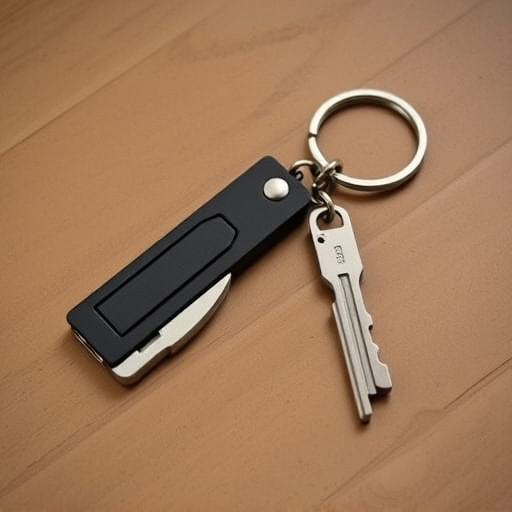Non-lethal keychain defense tools offer individuals compact, portable self-protection options without causing permanent harm. They utilize technologies like electric shocks, pepper spray, or noise to temporarily incapacitate attackers. When selecting a tool, prioritize safety features such as automatic locking mechanisms and durable construction. Proper training is essential for understanding deployment range, activation methods, and safe use to minimize harm. Legality varies globally; responsible handling, storage, and adherence to local laws are crucial. Regular maintenance and familiarity with the device's mechanics ensure reliability in emergencies.
In today’s unpredictable world, personal safety is paramount. Portable keychain weapon safety features offer a discreet yet potent solution for self-defense. This article explores non-lethal keychain defense tools, delving into their safety features, effective use, and legal considerations. Understanding these aspects empowers individuals to make informed choices, ensuring maximum protection while adhering to responsible ownership practices. Key topics include the benefits of non-lethal force and practical training guidelines.
- Understanding Non-Lethal Keychain Defense Tools
- Safety Features to Consider When Choosing a Keychain Weapon
- Effective Use and Training for Maximum Protection
- Legal Implications and Responsible Ownership of Portable Keychain Weapons
Understanding Non-Lethal Keychain Defense Tools
Non-lethal keychain defense tools are designed to provide individuals with a means of self-protection without causing permanent harm or fatal injuries. These compact and portable devices are often in the form of keychains, making them easy to carry and ensuring that you’re always prepared. They utilize various non-lethal force technologies such as electric shocks, pepper spray, or noise to incapacitate an assailant temporarily.
Understanding how these tools work is essential when considering their safety features. Electric shock keychain weapons, for instance, emit a powerful electrical current that disrupts the nervous system, causing muscle spasms and temporary paralysis. Similarly, pepper spray keychains release a potent solution that irritates the eyes, nose, and throat, enabling the user to create distance from an attacker. Each type of non-lethal defense tool comes with its own set of safety measures, including automatic shut-off mechanisms, safety locks, and user-friendly design features to prevent accidental activation.
Safety Features to Consider When Choosing a Keychain Weapon
When considering a keychain weapon for personal safety, it’s crucial to look beyond its compact design and focus on the integrated safety features. Non-lethal keychain defense tools are designed to incapacitate an attacker temporarily without causing permanent harm. Look for models with automatic locking mechanisms that secure the weapon instantly upon deployment, minimizing the risk of accidental discharge. Additionally, consider those equipped with safety switches or triggers that require a deliberate action to activate, ensuring you have control over when the tool is in use.
The build quality and materials used also play a significant role in safety. Opt for keychain weapons made from durable, high-strength alloys or advanced composite materials known for their resilience and resistance to damage. Some models feature impact-absorbing components that can help reduce the force transferred to your hand during use, minimizing the risk of injury. Always check for certifications and user reviews that attest to the safety and reliability of the product.
Effective Use and Training for Maximum Protection
For maximum protection, it’s crucial to understand that non-lethal keychain defense tools are most effective when used appropriately and with proper training. These portable devices are designed to incapacitate or deter an assailant temporarily, giving users time to escape potentially dangerous situations. Effective use requires understanding the tool’s range, activation mechanisms, and safe distance. Training should cover correct grip, targeting key areas, and minimizing collateral damage to bystanders.
Regular practice sessions help users develop muscle memory for deployment, ensuring they can react quickly in stressful scenarios. It also allows them to learn how to control the force applied, which is critical when de-escalating situations. Additionally, understanding local laws regarding self-defense tools is essential to ensure legal protection and avoid unintended consequences.
Legal Implications and Responsible Ownership of Portable Keychain Weapons
The legality of portable keychain weapons varies significantly across regions, with some areas permitting their possession while others strictly regulate or ban them entirely. It’s crucial for owners to thoroughly understand local laws to avoid legal repercussions. Non-lethal keychain defense tools are designed to incapacitate or deter an attacker temporarily, but they must be used responsibly and only as a last resort. Owners should undergo appropriate training to ensure safe handling and deployment, preventing accidental harm to oneself or others.
Responsible ownership includes keeping the device secured when not in use, storing it out of reach of children, and being mindful of public spaces where its display might cause alarm. Regular maintenance and familiarity with the device’s mechanics are essential to guarantee its reliability in an emergency situation. Moreover, owners should be aware of their rights and responsibilities, fostering a culture of self-defense that prioritizes safety and legal adherence.
Portable keychain weapons, or non-lethal keychain defense tools, offer individuals a sense of security in various situations. When choosing such a device, it’s crucial to consider safety features like durable construction, automatic locking mechanisms, and user-friendly activation methods. Proper training is essential for effective use, ensuring users understand the legal implications and responsibilities associated with owning such devices. By adhering to safety guidelines and promoting responsible ownership, non-lethal keychain defense tools can provide peace of mind without compromising safety.
